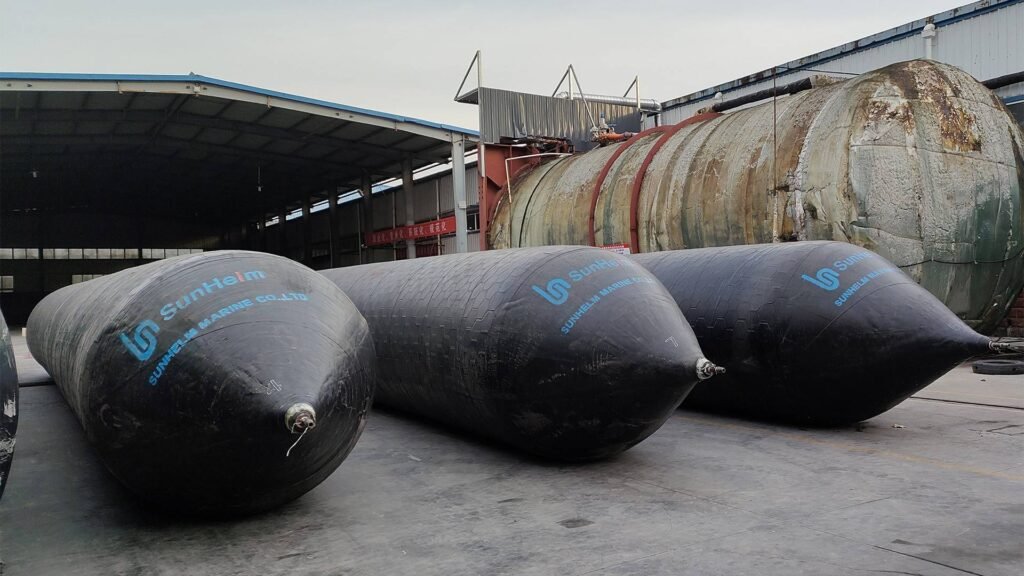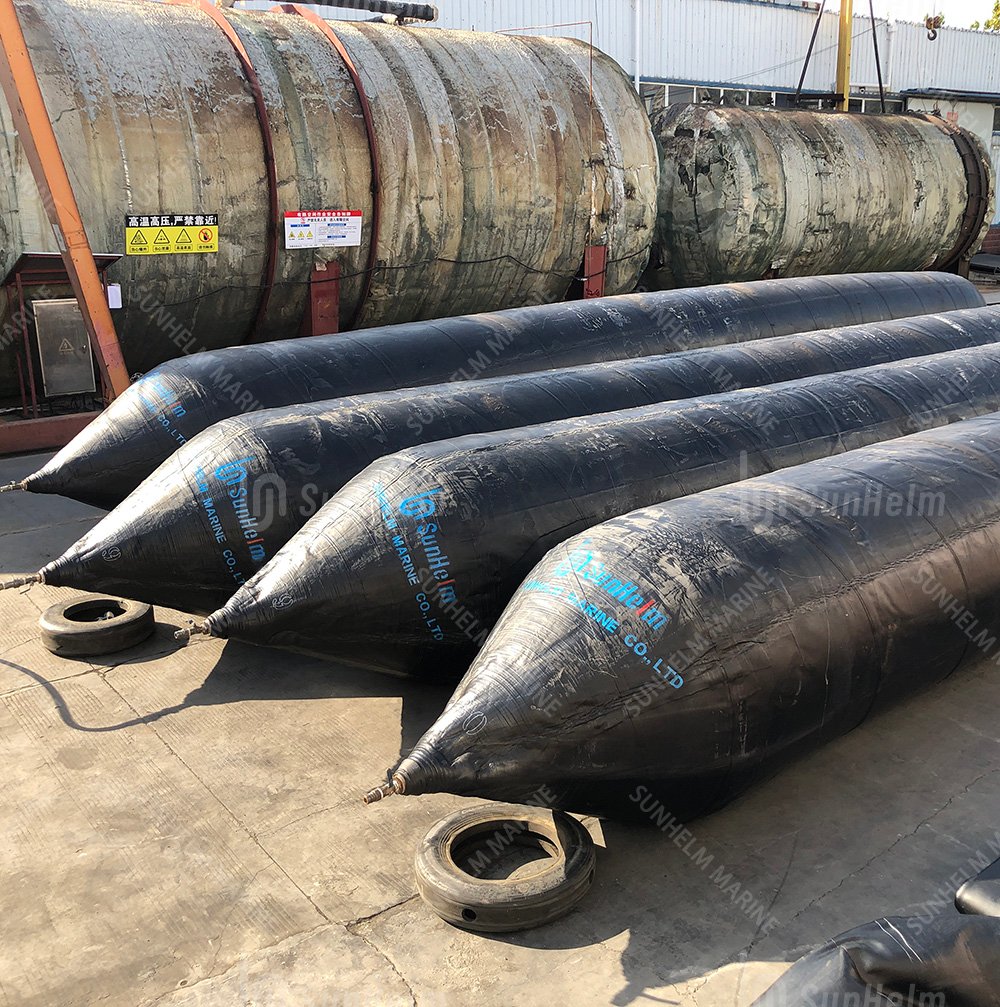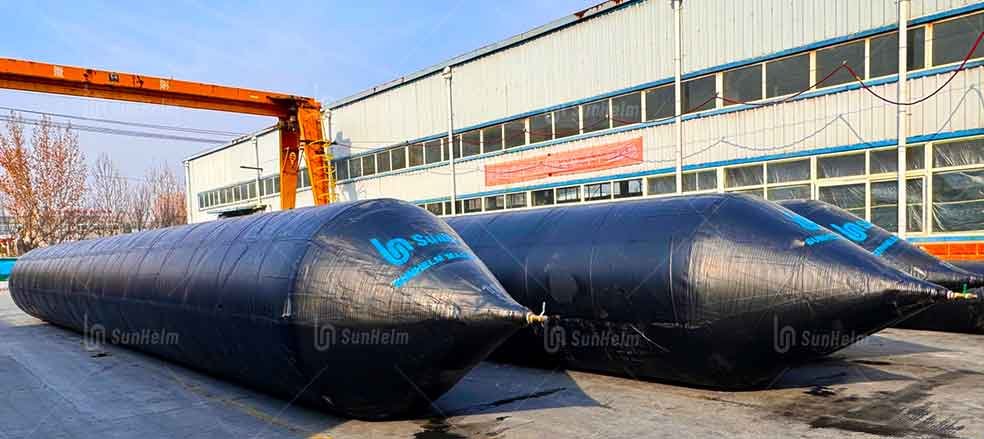When it comes to ship launching airbags, one of the most common questions we hear from shipyards and marine engineers is: “If we repair an airbag, how long will it last?” The short answer is: a well-repaired ship launching airbag can still serve reliably for many launches, but its lifespan depends on several factors — including the type of damage, repair quality, operating conditions, and maintenance habits.
In this guide, we’ll break down how repairs affect airbag performance, what to expect in terms of remaining service life, and how to maximize safety and return on investment.

What Affects the Lifespan of Repaired Ship Launching Airbags?
Not all damages are equal, and neither are repairs. The service life of a repaired ship launching airbag is influenced by multiple factors:
- Type and extent of damage
Minor surface abrasion or shallow cuts are easy to fix and often have little impact on lifespan. Structural damage involving multiple rubber layers or exposed synthetic cords is more serious and shortens the airbag’s remaining life. - Repair quality and materials
Using original-grade rubber sheets, correct vulcanization techniques, and skilled workmanship are essential. Poor repairs can lead to leaks, bulges, or uneven rolling during launches. - Operating conditions
Launching a 3,000 DWT fishing vessel is very different from launching a 20,000 DWT bulk carrier. Heavier vessels and rougher slipways stress ship launching using airbags more. - Inflation discipline
Overinflation accelerates fatigue and risks bursting; underinflation can cause deformation. Following the manufacturer’s recommended pressure chart is key. - Environment and storage
UV exposure, oil contamination, humidity, and ozone all reduce the lifespan of marine rubber. Proper storage can make a big difference.
Typical Lifespan Scenarios After Repair
To better understand expectations, here are a few common scenarios:
| Damage Type | Repair Method | Expected Remaining Life |
|---|---|---|
| Cosmetic abrasion / surface cracks | Light patch + protective coating | ≈90–100% of original lifespan |
| Single-layer cut | Proper scarf patch + hot vulcanization | ≈70–80% of original lifespan |
| Multi-layer deep cut | Multiple patches + reinforced cords | ≈50–60% of original lifespan |
| Valve or rope net damage | Component replacement | Minimal effect if airtightness is restored |
| Severe seam separation / heat damage | Repair not recommended | Replace the airbag |
Tip: If you need to repair the same airbag more than two times, it’s usually safer and more economical to replace it.
Inspection and Testing After Repair
Before trusting a repaired airbag for another launch, thorough testing is critical:
- Pressure hold test
Inflate the airbag to working pressure and monitor for leaks over at least 24 hours. - Visual inspection
Check for blistering, bulges, or irregularities along the repaired area. - Surface check
Use soapy water or ultrasonic leak detection to confirm airtightness. - Dimensional check
Ensure diameter, roundness, and wall thickness are within specifications.
A documented inspection log adds a safety buffer and is especially important for heavy vessel launches.

How to Extend the Life of Repaired Airbags
Even after repair, proper maintenance can significantly improve performance and safety:
- Clean and protect: Rinse the ship launching airbag after each use and apply a UV-protective coating.
- Store correctly: Keep them inflated slightly, off the ground, away from direct sunlight and ozone sources.
- Handle with care: Avoid dragging airbags across rough surfaces; use proper lifting straps.
- Routine checks: Perform visual inspections before each launch and deep inspections monthly.
- Annual certification: For shipyards handling large vessels, yearly testing is strongly recommended.
Safety Margins Matter
For critical launches, especially involving large tonnage vessels, it’s safer to de-rate repaired airbags:
- Use one extra airbag compared to the usual count.
- Keep operating pressure within 80–90% of maximum.
- Always have a contingency plan if pressure drops during the launch.
This conservative approach reduces risks and protects both personnel and vessels.
FAQs About Repaired Ship Launching Airbags
Q1. How many times can an airbag be repaired?
Usually no more than two times. Beyond that, structural fatigue increases risk significantly.
Q2. Can repaired airbags handle heavy ship launches?
Yes, if the repair is certified, but for vessels above 10,000 DWT, it’s better to include extra airbags for safety.
Q3. Do repaired airbags need lower inflation pressure?
In most cases, yes. Use the minimum effective pressure rather than the maximum rating.
Q4. How do I know when to retire an airbag?
Immediate retirement is advised if you find severe cord exposure, persistent leaks, seam separation, or bulging under test pressure.
Conclusion
Repaired ship launching airbags can remain highly reliable — but only if the damage is minor, repairs are performed professionally, and maintenance is consistent. Always inspect repaired airbags carefully, document testing, and apply safety margins when planning launches.
When in doubt, remember: your vessel’s safety is worth more than stretching an airbag’s life too far.


